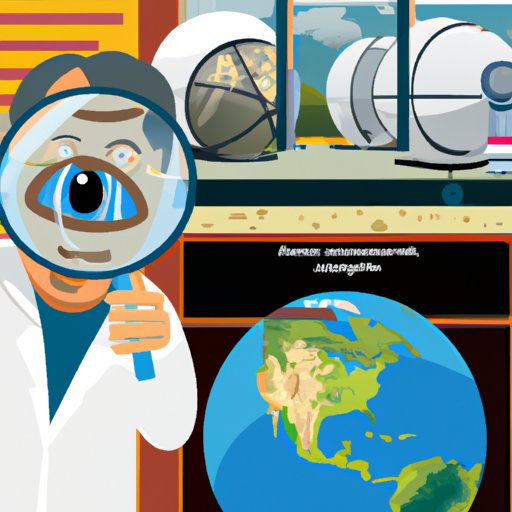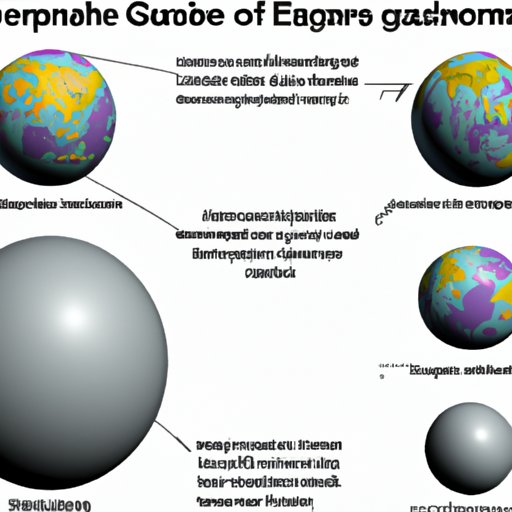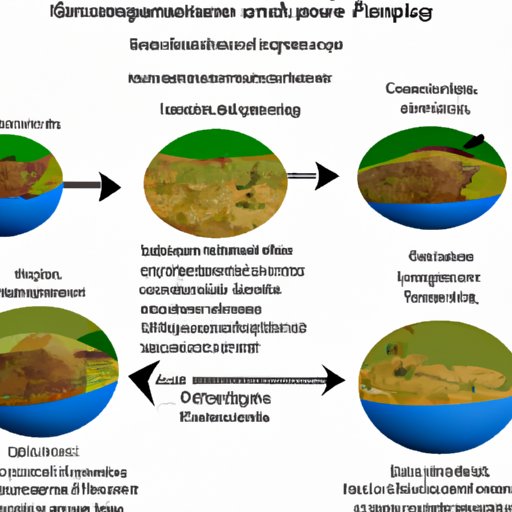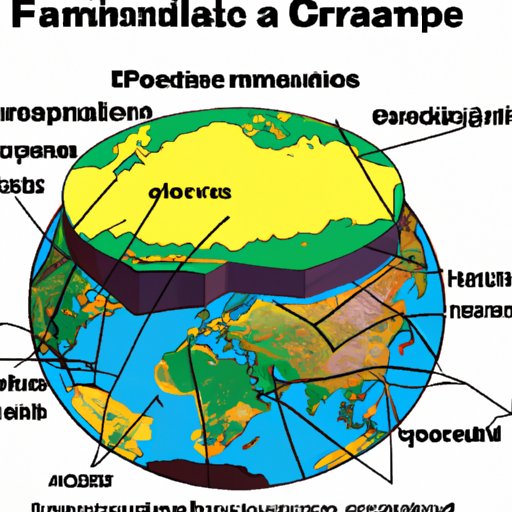Introduction
The geosphere is a complex concept that encompasses many aspects of Earth science. It refers to the physical features and dynamics of the planet, including its landforms, oceans, atmosphere, and interior structure. In this article, we will explore what geosphere means in science, from its definition to its various components and processes. We will also look at how scientists study the geosphere and discuss some of the current research being conducted in the field.
Defining the Geosphere: A Primer on Earth Science
At its most basic level, the geosphere is the solid part of the Earth, which includes the crust, mantle, and core. This portion of the planet is composed of rocks, minerals, and other materials that form the surface of our planet. The geosphere also encompasses the dynamic processes that shape and reshape the Earth, such as plate tectonics, erosion, volcanic activity, and seismic activity.
Earth science is the scientific study of the geosphere and its various components, processes, and interactions with the environment. It incorporates a variety of disciplines, including geology, geography, oceanography, meteorology, atmospheric sciences, and ecology. Scientists use a range of tools and techniques to study the geosphere, from fieldwork and lab experiments to remote sensing and computer modeling.

Exploring the Geosphere: How Scientists Study Our Planet
Scientific methods are used to study the geosphere in order to gain a better understanding of its components and dynamics. These methods include field observations, laboratory experiments, aerial and satellite imagery, and computer simulation. By combining these different approaches, scientists can build a comprehensive picture of the geosphere and its various systems and processes.
For example, geologists study the Earth’s crust and mantle through field observations and laboratory analysis. They observe and measure rock types, sedimentary deposits, and mineral composition in order to understand the structure and composition of the Earth’s crust and mantle. They also use seismic waves to map the interior of the Earth and gain a better understanding of its structure and composition.
Oceanographers study the oceans and their interaction with the atmosphere. They use a variety of instruments, such as buoys, sensors, and satellites, to measure temperature, salinity, currents, and other oceanic parameters. Meteorologists use observational data and numerical models to study weather patterns and how they affect the geosphere. Atmospheric scientists use these same techniques to study the chemical composition of the atmosphere and how it affects the Earth’s climate.
Geophysicists use a combination of field observations, laboratory experiments, and computer simulations to study the Earth’s interior. They measure the Earth’s magnetic field, gravitational field, and seismic waves in order to gain a better understanding of the Earth’s structure and composition. They also use computer models to simulate the Earth’s interior and predict its behavior.
The Geosphere: What We Know and What We Don’t
As a result of years of research, we now have a better understanding of the geosphere and its various components and dynamics. We know that the Earth is composed of a number of distinct layers, including the crust, mantle, and core. We also have a better understanding of the processes that shape and reshape the Earth, such as plate tectonics, erosion, volcanism, and seismic activity. In addition, we know more about the oceans and atmosphere and how they interact with each other and with the land.
However, there are still many areas of the geosphere that are not fully understood. For example, we do not yet fully understand the composition and structure of the Earth’s interior, or how the various layers interact with each other. We also do not yet fully understand the long-term impacts of climate change and how it may affect the geosphere in the future.

The Geosphere: An Overview of its Components and Dynamics
The geosphere is composed of several distinct components, each of which plays an important role in shaping the planet. The outermost layer of the geosphere is the crust, which is composed of solid rock and sediment. Below the crust is the mantle, which is made up of hot, semi-solid rock. At the center of the Earth is the core, which is composed of a dense, iron-rich material.
These three main layers are constantly in motion due to the process of plate tectonics. The plates move and interact with one another, causing earthquakes, volcanoes, and other geological phenomena. In addition, the oceans and atmosphere play an important role in the geosphere, as they are constantly interacting with the land and influencing its processes.

Geosphere Processes: Examining Their Effects on the Environment
The geosphere is constantly changing and evolving, and its processes have a significant impact on the environment. Weather patterns, for example, are driven by the interaction between the atmosphere and land. As the air moves over the land, it carries heat and moisture, which can lead to precipitation, storms, and other weather events. Climate change is also driven by the geosphere, as changes in the atmosphere and land can lead to changes in global temperatures.
In addition, human activities can have a major impact on the geosphere. For example, deforestation can cause soil erosion, while the burning of fossil fuels can release pollutants into the atmosphere. These activities can have a direct effect on the environment, leading to changes in weather patterns, sea levels, and other aspects of the geosphere.
The Geosphere Through Time: How it has Changed Over the Ages
The geosphere has evolved and changed over the course of Earth’s history. Over millions of years, the continents have moved, mountains have been formed, and oceans have come and gone. Human activities have also had an impact on the geosphere, from deforestation to the burning of fossil fuels.
By studying the geosphere through time, scientists can gain a better understanding of the processes that shape and reshape the planet. This knowledge can be used to better predict and prepare for future changes in the environment, as well as to develop strategies for mitigating the effects of human activities on the geosphere.
Conclusion
In this article, we explored what geosphere means in science. We discussed how scientists study the Earth’s physical features and dynamics, and examined the various components and processes of the geosphere. We also looked at how the geosphere has changed over time and the impacts of human activities on the environment. Finally, we discussed the implications of this research for future studies of the geosphere.
Overall, the geosphere is a complex and ever-changing system that is constantly being shaped and reshaped by natural and human forces. By studying the geosphere, scientists can gain a better understanding of the planet and its processes, and use this knowledge to inform policy decisions and prepare for future changes.
(Note: Is this article not meeting your expectations? Do you have knowledge or insights to share? Unlock new opportunities and expand your reach by joining our authors team. Click Registration to join us and share your expertise with our readers.)
